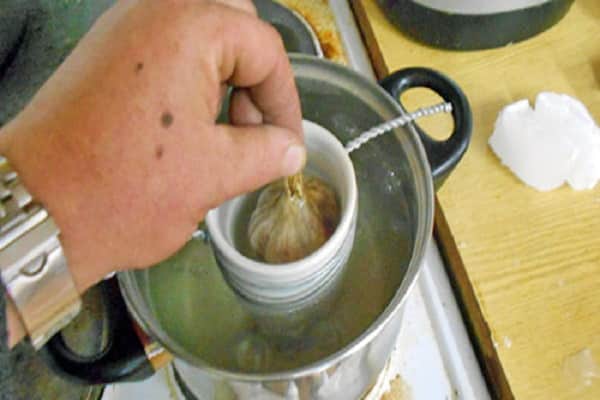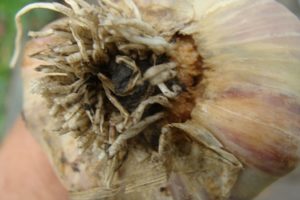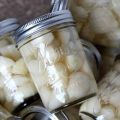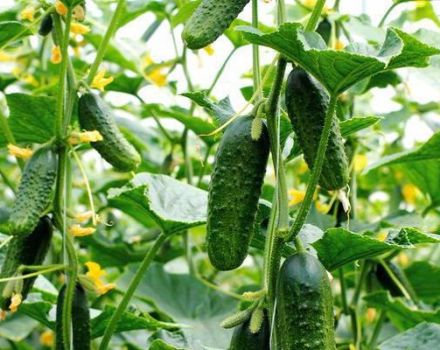How to properly store garlic at home after digging up?
The ease of growing a garlic crop usually results in bountiful harvests of this herbaceous perennial vegetable and the annual challenge of keeping the garlic until the next harvest. There are many ways of storing the culture, however, not all of them are capable of providing good keeping quality of a spicy and aromatic vegetable. Can garlic be frozen and which cultivar of Alliaceae can survive the winter better?
Conditions for the correct collection of garlic
Any garlic that is timely removed from the garden and properly prepared is subject to storage, including long-term storage, until the new harvest. It is believed that spring garlic harvested in the last month of summer is much more hardy than its winter counterpart, but a large number of reviews from experienced agronomists have made adjustments to this information about the storage of the product. It turns out that in most cases of growing winter crops, many gardeners for some reason omit the need for a number of actions to decontaminate seed material, and when faced with a vegetable disease or the fact of rotting of the head in the ground, they do not always work to find out the cause and allow diseases to cover large areas of sowing.
An important role for proper storage is played by the correct determination of the timing of harvesting vegetable crops:
- spring garlic, removed from the garden after August 20;
- the winter vegetable is kept in the garden until mid-July.
You can determine the readiness of the culture for digging, focusing on the state of the green part of the plant stem... Closer to the due date, the tops of the vegetable begins to turn yellow, dries up from the outer leaves and lowers the stems to the ground - "spreads". It is impossible to overexpose planting material in the soil, just as it is impossible to carry out watering garlic in the last 10–12 days before harvesting the crop - all this contributes to the release of young shoots by the bulbs and the disintegration of the garlic head into separate cloves. In this state, the dug out bulbs are only useful for storage in a processed form.

Immediately after the whole culture is dug up, it is sorted out, throwing aside all the spoiled or not tight enough to the touch, bulbs. Right there, in the garden, on wooden or metal boards, the first drying of garlic is carried out after harvesting. The vegetable dries in the shade, always together with the tops and the entire green part of the plant. At night, the onions are removed indoors, and for the day they are put out again - and so, for at least 4 days.
How should garlic be stored after digging so as not to worry about having a vegetable on the table until the next harvest?
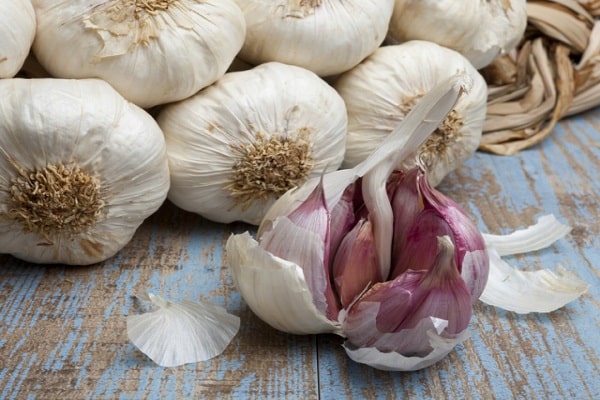
Where to store garlic?
Storage of garlic in a cellar or pantry should be carried out in compliance with the temperature regime, which does not allow the thermometer to deviate from the optimal + 3 ... + 6 degrees. It is not recommended to use metal garage boxes or damp basements for storing this vegetable - the humidity level in them can reach 80-100%, and at such values, the garlic will either dry out or begin to soften and rot.
It is best to hang the garlic from the ceiling after harvesting. There are many methods to do this, from braiding dried garlic stalks into pigtails, forming a kind of "vine", to using small baskets or mesh "avoski", in which garlic will be well ventilated in winter. If it is not possible to provide the vegetable with "air space", the undamaged heads in one row are laid out in flat boxes with perforations in the side walls and placed on racks.

To prevent the stored vegetable from becoming damp, you cannot place a tab with garlic near the boxes with carrots, turnips, beets, radishes, cabbage. The only worthy neighbor of the culture during storage will be well-dried onions.
There is another option to extend the shelf life of untreated vegetable heads - to store in the refrigerator. Whole vegetable heads are placed in 3-5 pieces in small bags of craft paper and occupy a separate vegetable container in the lower section of the refrigerator. Garlic is stored in this form for a short time - up to three weeks, so most housewives choose a more troublesome but reliable storage method - freezing the onions in the freezer. This storage method is also good in that the so-called "illiquid" - a spoiled vegetable, from which you need to cut off the damaged areas, and then chop the teeth with a knife or in a meat grinder, is also suitable for it.
The resulting gruel or, if desired, whole peeled teeth are tightly packed in special tight bags for low temperatures and these briquettes are stored in the freezer as long as needed. What is the best temperature for storing garlic? It is preferable to store frozen briquettes with vegetables at -4 ... -7 degrees and never defrost them whole, if there is no need to use the whole mass.
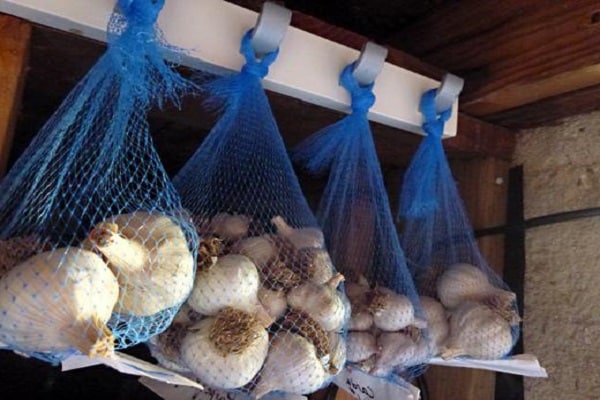
How to store garlic at home?
Processed garlic, during storage, should have a protective or nourishing environment in which its beneficial qualities would not undergo changes, and the life of the vegetable was extended for a long period.
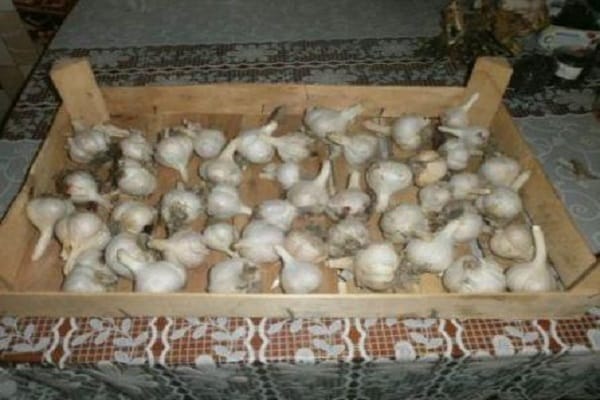
Storage in oil
This way of storing garlic is loved by those who prefer to add the flavorful vegetable to soups and salad dressings. In vegetable oil, garlic partially loses its pungency, but instead, it becomes very fragrant, saturating even the filling liquid with a thick aroma. The scheme for cooking a vegetable in oil is simple:
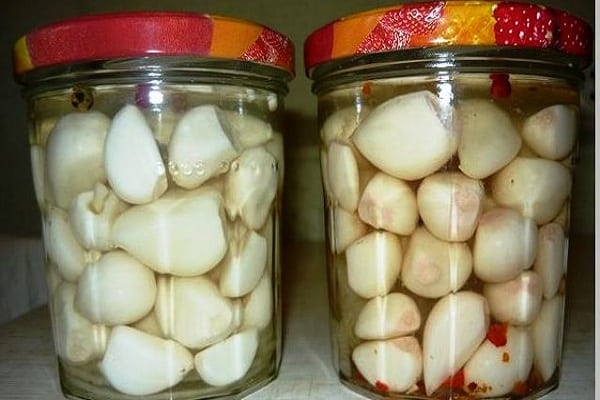
- garlic cloves are peeled and chopped with a knife;
- the spicy mass is transferred to a small jar, filling it 2/3;
- in a thin stream and with constant stirring of the liquefied gruel, vegetable oil is poured into the jar, complementing the container to the "shoulders";
- the garlic in the jar is closed with a plastic lid and put into the refrigerator for storage.
In the sunflower oil left over after using the vegetable, you can prepare first courses and even use it for medicinal purposes. The shelf life of the workpiece is up to 3 months.
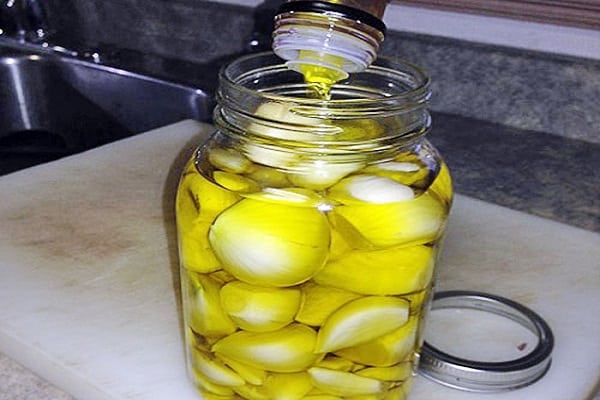
Garlic alcoholic tincture
Medicinal garlic tincture is often mentioned in medical reference books, therefore, in a house where there are patients with cardiovascular pathologies, such a winter preparation will come in handy. To get an elixir from a vegetable, you need a minimum of actions and a little waiting:
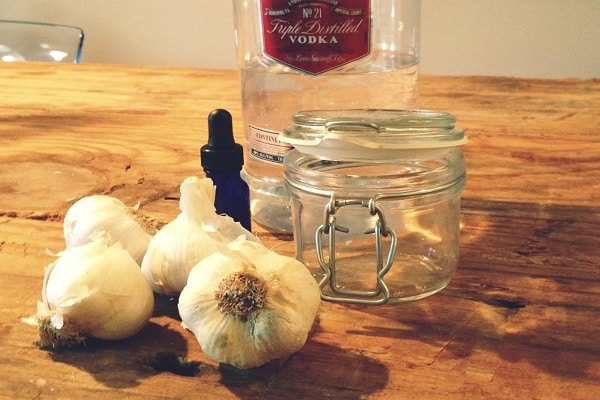
- two glasses of garlic, minced in a meat grinder, peeled cloves of garlic, insist in a closed jar for about an hour and a half;
- after insisting, remove the entire top layer of the mass with a spoon - about a third of the total amount, and the remaining gruel is transferred to a sterilized 0.5-liter bottle of dark glass and poured with a glass of high-quality alcohol;
- the closed bottle is stored in a secluded place for a week and a half, after which the tincture can be consumed.
The "removed" garlic does not need to be thrown away - the best way to store it is in a jar of oil, according to the previous method, or, as an option, in the freezer.

How to store unshelled garlic correctly?
Storing garlic at home can be carried out without additional processing of the vegetable. Thus, you can store garlic in an apartment for up to six months, and it retains its original taste and aroma longer.
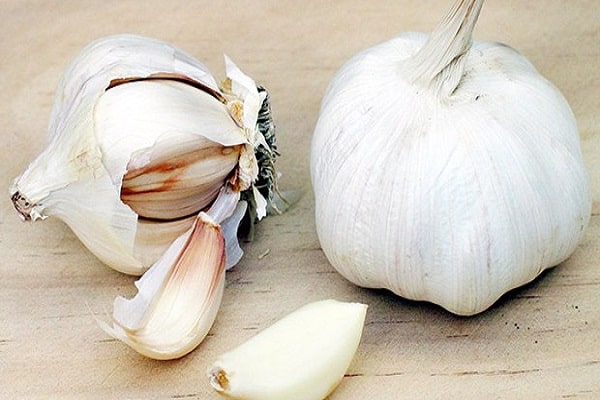
Use of bulk materials
The storage of garlic in flour, coarse table salt or wood ash is justified by the moisture-absorbing properties of these sorbents. The use of any of the substances allows you to store the prepared vegetable directly in the kitchen, without allocating a separate room, such as a basement or pantry:

- Flour. The bottom of a flat plastic container is covered with a layer of flour and garlic heads of the same size are evenly placed on it. Using a sieve, plentifully crush a dense row of onions with flour and tightly close the container for further storage.
- Salt. As a container, take small perforated boxes or corrugated cardboard boxes with holes in the lid. It is allowed to stack up to three layers of garlic heads in one container, so as not to crush the bottom row with the weight of the onions with salt. Using glass 1–2-liter jars instead of a box extends the shelf life of the vegetable for another month or two, the main thing is not to forget to generously sprinkle salt on the topmost layer of the stacked heads.
- Ash. The method of laying a vegetable is exactly the same as the previous one. It is better to store a box with ash contents near heating radiators.
If the storage of garlic in a city apartment is carried out in a pantry or in the kitchen, it is necessary to ensure that there are no potato, cabbage, beetroot bookmarks next to the capricious vegetable that spread dampness and can cause rotting of the culture.
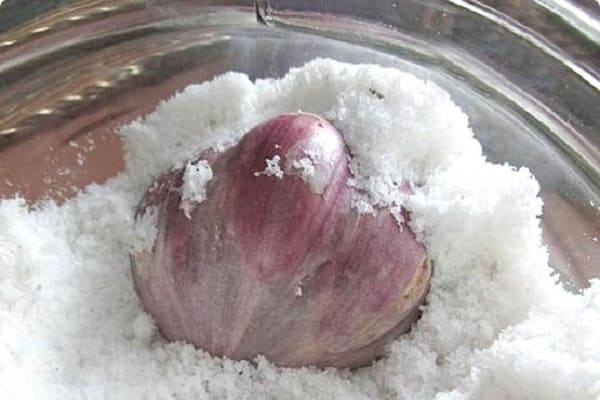
"Paraffin shirt"
For waxing, choose vegetable heads of the same, medium size, with tightly merged teeth and with intact husks. The lower part of each head, from where the roots begin to grow, is cauterized. In a heat-resistant container, over low heat or in a water bath, melt broken wax candles or lump paraffin to a liquid state.
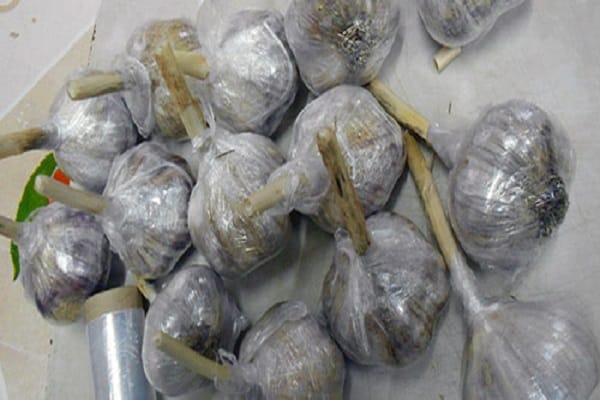
Each head of garlic is taken separately by the dry stem and immersed in liquid, holding the vegetable in paraffin for exactly 3 seconds. Then the heads of the vegetable are planted in one row in a flat box and stored in a cool place, away from sunlight. In a paraffin coating, garlic of winter varieties is stored until January-February, spring varieties - until approximately June.
Whatever option the hostess chooses to store a spicy spicy vegetable (the exception is freezing), it should be remembered that there is no universal way to protect the vegetable from damage, which means that due to one damaged clove of garlic, there is a risk of rotting of the entire styling. At least once a month and a half, you need to sort out the stocks, probing the garlic heads and assessing the smell coming from the box (jar) with the vegetable.
